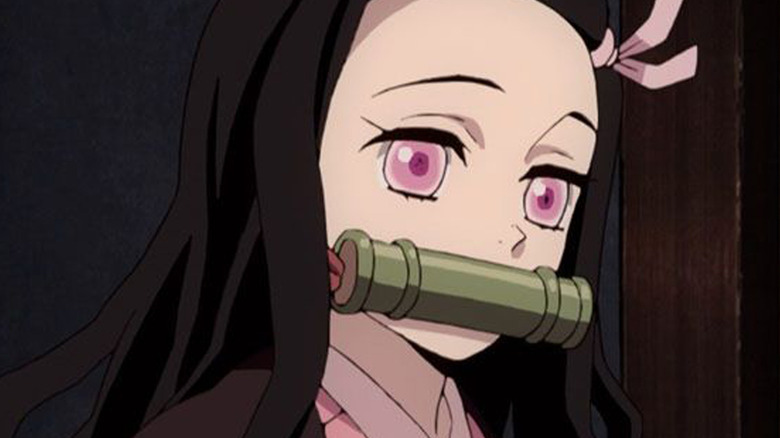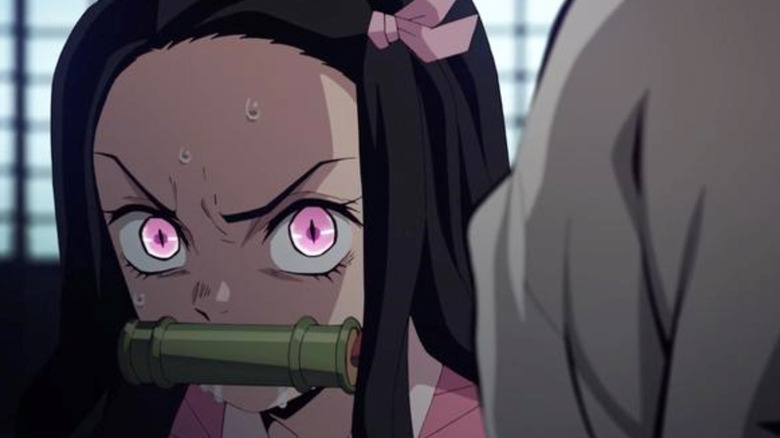Why Nezuko's Name Means More Than You Think In Demon Slayer
"Demon Slayer: Kimetsu no Yaiba" has become one of the most recognizable names in recent anime history thanks to the meteoric success of "Demon Slayer: Kimetsu no Yaiba the Movie: Mugen Train." The movie serves not as a spinoff, like many theatrical adaptations of popular anime properties before it, but as a direct continuation of the first season of "Demon Slayer." When the film debuted in Japan in October 2020, it broke box office records and became the fastest film in Japanese history to earn 10 million yen. Since then, it has become the most financially successful movie to ever be released in Japan, period (via Kotaku).
"Mugen Train" debuted in U.S. theaters in April 2021. It then went on to set a new record for the highest-grossing opening weekend for a non-English film in the U.S. The previous record-holder was the Jet Li-starring "Hero," which debuted stateside in 2004. Even prior to the historic popularity of "Mugen Train," however, "Demon Slayer" was a hit in its own right as a traditional televised anime series. Domestically, its first 26-episode season is available on Netflix, where the show is a streaming hit.
In its pilot episode, a boy named Tanjiro returns to his remote mountain home to find most of his family slaughtered by a demon who has since left the scene of the crime. The only survivor is Tanjiro's sister Nezuko, though she is no longer human but transformed into a demon. Tanjiro vows from then on to protect Nezuko, whose remaining vestiges of humanity allow her to live discreetly as a demon in human society. Integral to Nezuko's character is the tension between her demonic instincts and her human past. Her name, in fact, contains a reference to that very tension.
A soybean a day keeps the demons away
In Japanese, Nezuko's given name is written 禰豆子, with each character corresponding to one syllable. The first character, 禰, pronounced "ne," is a relatively obscure word meaning "ancestral shrine" (via Nihongo Master) when in isolation. A Google image search for the character returns primarily depictions of none other than Nezuko rather than any sort of shrine, seemingly indicating a relative lack of use as a discreet character. While the third character, 子, pronounced "ko," literally means "child" (via Nihongo Master), it's also frequently the final character in girls' names, lacking much significance to Nezuko's characterization beyond indicating that her name is indeed a girl's name.
It's the middle character in Nezuko's name, however, that's most significant. On its own, 豆 can be pronounced "mame" and signifies beans (via Nihongo Master). While Nezuko herself isn't particularly beanlike, she is a demon, and the combination of beans and demons has precedent in Japanese culture. The Japanese holiday Setsubun takes place each year in early February, and, among various other traditions, involves throwing roasted soybeans as a demon deterrent while chanting "鬼はそと福はうち" (which can be translated roughly as "demons out, happiness in") (via Japan Guide).
Nezuko's name, then, evokes a folk tradition designed to keep demons at bay. Nezuko herself, while a demon, is on the side of the Demon Slayer Corps, themselves trying to keep a very real demon threat at bay. Furthermore, her personal struggle revolves around efforts to suppress her own demonic nature. So, while Nezuko remains a demon in "Demon Slayer," her very name will remind some Japanese-speaking fans of her allegiance to humankind above all else.

